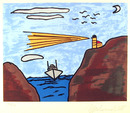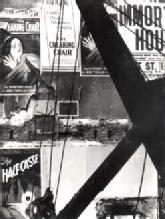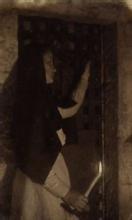Muhammad Ali, Guiding Light, Signed Serigraph
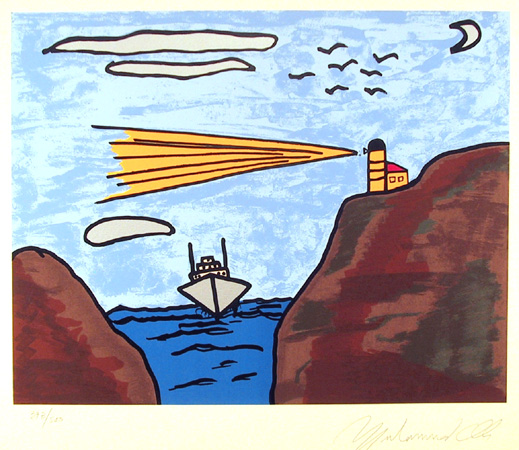
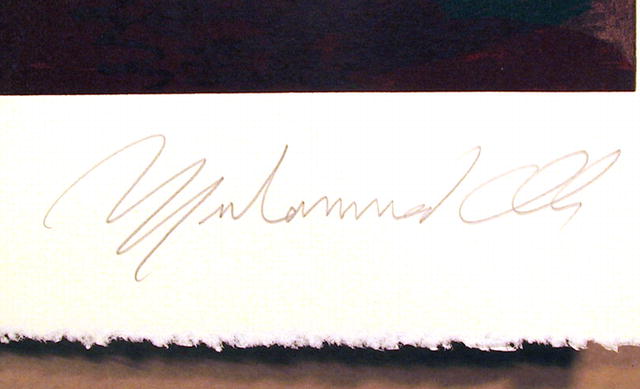
Unavailable
Artist: Muhammad Ali
Title: Guiding Light
Year: 1979
Medium: Serigraph, signed and numbered in pencil
Edition: 500
Paper Size: 22" x 25"
Muhammad Ali
Who wouldve thought that a stolen bike was the key to the beginning of the Muhammad Ali story? But it was. In 1954 in Louisville, Kentucky, 12-year-old Cassius Marcellus Clays bike was stolen while he and a friend were at the Columbia Auditorium.
Young Cassius found a cop in a gym, Joe Martin, and boiling with youthful rage, told Martin he was going to "whup" whoever stole his bike. Martin admonished, "You better learn to box first." Within weeks, 89-pound Cassius had his first bout---his first win.
For the next 27 years, Cassius would be in that ring. Even in his youth, he had dreams of being heavyweight champion of the world. But his life would take turns that no seer couldve predicted.
Young Cassius dedicated himself to boxing with fervor unmatched by other young boxers. Indeed, it was his only activity. As a teenager, he never worked. He boxed and trained. He had 108 amateur bouts. According to Joe Martin, Clay set himself apart from the other boys by two things: He was "sassy," and he outworked all the other boys. The work paid off: 6 Kentucky Golden Gloves championships; two National Golden Gloves championships; two National AAU titles before he was 18 years old. And the son of Odessa, whom he lovingly referred to as "Bird," and Cassius senior, "Cash," to everyone, won the Olympic Gold Medal in 1960 in Rome months after his 18th birthday.
Although Cassius returned home to a parade, Louisville was still, in 1960 part of the segregated South. Even with a medal around his neck, Cassius was refused service at a local restaurant.
At the time, Cassius has managed by the Louisville Sponsoring Group, a consortium of wealthy local white businessmen. The LSG, as it became known, put young Cassius with veteran trainer, Angelo Dundee, after failed attempts to with the Mongoose, Archie Moore, and a turn down by Alis boxing idol, Sugar Ray Robinson.
With Dundee in his corner, from his Miami base, Cassius blazed a trail through the heavyweight division with his unorthodox style that defied boxing logic. He was a "headhunter." He never threw body shots (he adopted this style in his youth because he had reach and because he didnt want to get close enough to get hit). And he "danced." Because of Clays powerful legsmaybe the strongest in the history of boxinghe literally floated in the ring. He invented the "Ali Shuffle;" a foot maneuver where he would elevate himself, shuffle his feet in a dazzling blur, and sometimes deliver a blow while dancing.
The third element that Clay brought to boxing was his mouth. He never shut up. He became known as, "The Louisville Lip." It was more than banter; it was a constant harangue. In a time when boxers never talked to the media---their managers always spoke for them---Clay did all his own talking. He even went so far as to predict the round. "To prove Im great he will fall in eight!"
While training for his title bout against the fearsome heavyweight champion, Sonny Liston, Clay met Capn Sam, a Nation of Islam minister of the local Miami mosque. Capn Sam introduced Cassius to NOI spokesman, Malcolm X. Malcolm and young Cassius bonded on a deep level. Malcolm brought Cassius into the Nation of Islam.
Despite the 7-1 odds, Clay upset Sonny Liston in Miami and became heavyweight champion of the world in 1964. The next day, Clay announced to the world that he was a member of the Nation of Islam and that his name was Cassius X. The X reflecting the unknown name that was taken from him by the slave owners centuries before.
The national response was immediate, negative and intense. Cassius X, soon to be given the name Muhammad Ali, by NOI founder, "The Messenger," the Honorable Elijah Muhammad, chose to disassociate himself from his friend and mentor Malcolm X after the Messenger suspended Malcolm. Herbert Muhammad, eldest son of Elijah, was installed as Alis new manager as Ali continued to defend his crown against all comers.
In 1967, as the Vietnam War was escalating, Ali was called up for induction into the Armed Services. Ali refused induction on the grounds of religious beliefs. He was, in fact, a practicing Muslim minister. This refusal led to the now-famous Ali quote, "I aint got no quarrel with them Vietcong "
The national furor over that comment combined with Alis refusal to be inducted into the Armed Services, caused virtually every state and local entity in America to cancel Alis boxing licenses. Ali final fight of 1967 was against Ernie Terrell, who incensed Ali at the weigh-in by calling him "Clay." Ali pounded him in the ring with taunts of, "Whats my name?!!"
Ali did not fight again for 2 ½ years. He was stripped of his championship title, his passport taken; all his boxing licenses were cancelled. He lost an initial court battle and was facing a 5-year prison term. Ali made money during his exile by speaking to colleges. He was the first national figure to speak out against the war in Vietnam.
In 1970, after a 2 ½ year layoff, and with the mood of the country changing, Ali staged his comeback, first against Jerry Quarry in Atlanta then for what was billed as, "The Fight," his first match against undefeated champ, Joe Frazier at Madison Square Garden on March 8, 1971.
Ali fought valiantly, but lost. The 2 ½ year exile had cost Ali his legs. He could no longer dance. He lost that night in the Garden, but months later he won his biggest fight, the Supreme Court, reversed his conviction and upheld his conscientious objector claim. Ali was free of the specter of jail, and free to travel to box anywhere in the world.
Several matches followed, including an unexpected loss to ex-Marine, Ken Norton; a win in their next bout; an uninspired win against Joe Frazier. But these matches were but window dressing for the biggest match of Alis career: The Rumble In the Jungle.
George Foreman was a fearsome champ. He had thunder and destruction in both hands. He had easily knocked out Ken Norton and had lifted Frazier off the mat with one blow.
Promoter Don King got the government of the African nation of Zaire to guarantee the unheard of sum of 10 million dollars for the fighters. In Kinshasa, Ali derived strength from the African people. They adored him. They yelled, Ali Bomaye! (Ali kill him).
Going into the fight, Ali was 3-1 underdog. His fight doctor, Ferdie Pacheco, had a jet ready to spirit Ali away to a neurological hospital in Spain after the fight. But Ali had other ideas.
Because of the heat, Ali realized he couldnt dance from Foreman for the whole fight. He invented, "The Rope-A-Dope," a strategy that allowed Foreman to pound on him until Foreman tired. His corner men yelled at him to get off the ropes, but Ali persisted with his strategy for seven rounds and then in the eighth round, when Foreman was spent, Ali came off the ropes and scored a shocking knockout! Ali was the king again.
After the legendary "Thrilla In Manila," the rubber match against Frazier, who some have deemed, the greatest boxing match ever, Ali fought and lost to young Olympic Champion Leon Spinks. He subsequently regained his title against Spinks, thus becoming, at that time, the only man in heavyweight history to win the crown three times. Ali ended his career 56 wins (37 by knockout) and 5 defeats.
Ali has inspired millions worldwide. He gave people hope and proved that anyone could overcome insurmountable odds. He gave people courage. He made fighters of us all. This is Ali and never comes another.
____
Biography by: Gregory Allen Howard
He is the award-winning screenwriter of Remember the Titans. He also wrote the original story for the movie, ALI.
Title: Guiding Light
Year: 1979
Medium: Serigraph, signed and numbered in pencil
Edition: 500
Paper Size: 22" x 25"
Muhammad Ali
Who wouldve thought that a stolen bike was the key to the beginning of the Muhammad Ali story? But it was. In 1954 in Louisville, Kentucky, 12-year-old Cassius Marcellus Clays bike was stolen while he and a friend were at the Columbia Auditorium.
Young Cassius found a cop in a gym, Joe Martin, and boiling with youthful rage, told Martin he was going to "whup" whoever stole his bike. Martin admonished, "You better learn to box first." Within weeks, 89-pound Cassius had his first bout---his first win.
For the next 27 years, Cassius would be in that ring. Even in his youth, he had dreams of being heavyweight champion of the world. But his life would take turns that no seer couldve predicted.
Young Cassius dedicated himself to boxing with fervor unmatched by other young boxers. Indeed, it was his only activity. As a teenager, he never worked. He boxed and trained. He had 108 amateur bouts. According to Joe Martin, Clay set himself apart from the other boys by two things: He was "sassy," and he outworked all the other boys. The work paid off: 6 Kentucky Golden Gloves championships; two National Golden Gloves championships; two National AAU titles before he was 18 years old. And the son of Odessa, whom he lovingly referred to as "Bird," and Cassius senior, "Cash," to everyone, won the Olympic Gold Medal in 1960 in Rome months after his 18th birthday.
Although Cassius returned home to a parade, Louisville was still, in 1960 part of the segregated South. Even with a medal around his neck, Cassius was refused service at a local restaurant.
At the time, Cassius has managed by the Louisville Sponsoring Group, a consortium of wealthy local white businessmen. The LSG, as it became known, put young Cassius with veteran trainer, Angelo Dundee, after failed attempts to with the Mongoose, Archie Moore, and a turn down by Alis boxing idol, Sugar Ray Robinson.
With Dundee in his corner, from his Miami base, Cassius blazed a trail through the heavyweight division with his unorthodox style that defied boxing logic. He was a "headhunter." He never threw body shots (he adopted this style in his youth because he had reach and because he didnt want to get close enough to get hit). And he "danced." Because of Clays powerful legsmaybe the strongest in the history of boxinghe literally floated in the ring. He invented the "Ali Shuffle;" a foot maneuver where he would elevate himself, shuffle his feet in a dazzling blur, and sometimes deliver a blow while dancing.
The third element that Clay brought to boxing was his mouth. He never shut up. He became known as, "The Louisville Lip." It was more than banter; it was a constant harangue. In a time when boxers never talked to the media---their managers always spoke for them---Clay did all his own talking. He even went so far as to predict the round. "To prove Im great he will fall in eight!"
While training for his title bout against the fearsome heavyweight champion, Sonny Liston, Clay met Capn Sam, a Nation of Islam minister of the local Miami mosque. Capn Sam introduced Cassius to NOI spokesman, Malcolm X. Malcolm and young Cassius bonded on a deep level. Malcolm brought Cassius into the Nation of Islam.
Despite the 7-1 odds, Clay upset Sonny Liston in Miami and became heavyweight champion of the world in 1964. The next day, Clay announced to the world that he was a member of the Nation of Islam and that his name was Cassius X. The X reflecting the unknown name that was taken from him by the slave owners centuries before.
The national response was immediate, negative and intense. Cassius X, soon to be given the name Muhammad Ali, by NOI founder, "The Messenger," the Honorable Elijah Muhammad, chose to disassociate himself from his friend and mentor Malcolm X after the Messenger suspended Malcolm. Herbert Muhammad, eldest son of Elijah, was installed as Alis new manager as Ali continued to defend his crown against all comers.
In 1967, as the Vietnam War was escalating, Ali was called up for induction into the Armed Services. Ali refused induction on the grounds of religious beliefs. He was, in fact, a practicing Muslim minister. This refusal led to the now-famous Ali quote, "I aint got no quarrel with them Vietcong "
The national furor over that comment combined with Alis refusal to be inducted into the Armed Services, caused virtually every state and local entity in America to cancel Alis boxing licenses. Ali final fight of 1967 was against Ernie Terrell, who incensed Ali at the weigh-in by calling him "Clay." Ali pounded him in the ring with taunts of, "Whats my name?!!"
Ali did not fight again for 2 ½ years. He was stripped of his championship title, his passport taken; all his boxing licenses were cancelled. He lost an initial court battle and was facing a 5-year prison term. Ali made money during his exile by speaking to colleges. He was the first national figure to speak out against the war in Vietnam.
In 1970, after a 2 ½ year layoff, and with the mood of the country changing, Ali staged his comeback, first against Jerry Quarry in Atlanta then for what was billed as, "The Fight," his first match against undefeated champ, Joe Frazier at Madison Square Garden on March 8, 1971.
Ali fought valiantly, but lost. The 2 ½ year exile had cost Ali his legs. He could no longer dance. He lost that night in the Garden, but months later he won his biggest fight, the Supreme Court, reversed his conviction and upheld his conscientious objector claim. Ali was free of the specter of jail, and free to travel to box anywhere in the world.
Several matches followed, including an unexpected loss to ex-Marine, Ken Norton; a win in their next bout; an uninspired win against Joe Frazier. But these matches were but window dressing for the biggest match of Alis career: The Rumble In the Jungle.
George Foreman was a fearsome champ. He had thunder and destruction in both hands. He had easily knocked out Ken Norton and had lifted Frazier off the mat with one blow.
Promoter Don King got the government of the African nation of Zaire to guarantee the unheard of sum of 10 million dollars for the fighters. In Kinshasa, Ali derived strength from the African people. They adored him. They yelled, Ali Bomaye! (Ali kill him).
Going into the fight, Ali was 3-1 underdog. His fight doctor, Ferdie Pacheco, had a jet ready to spirit Ali away to a neurological hospital in Spain after the fight. But Ali had other ideas.
Because of the heat, Ali realized he couldnt dance from Foreman for the whole fight. He invented, "The Rope-A-Dope," a strategy that allowed Foreman to pound on him until Foreman tired. His corner men yelled at him to get off the ropes, but Ali persisted with his strategy for seven rounds and then in the eighth round, when Foreman was spent, Ali came off the ropes and scored a shocking knockout! Ali was the king again.
After the legendary "Thrilla In Manila," the rubber match against Frazier, who some have deemed, the greatest boxing match ever, Ali fought and lost to young Olympic Champion Leon Spinks. He subsequently regained his title against Spinks, thus becoming, at that time, the only man in heavyweight history to win the crown three times. Ali ended his career 56 wins (37 by knockout) and 5 defeats.
Ali has inspired millions worldwide. He gave people hope and proved that anyone could overcome insurmountable odds. He gave people courage. He made fighters of us all. This is Ali and never comes another.
____
Biography by: Gregory Allen Howard
He is the award-winning screenwriter of Remember the Titans. He also wrote the original story for the movie, ALI.
Rogallery
Long Island, New York
Dealer accepts: Check, Cash, PayPal, Authorize.Net
Shipping: Negotiated with Seller
